walking
June 20th, 2006 | Uncategorized
Yesterday I took a long city hike. God, I love walking in New York!
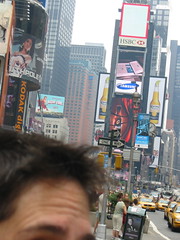
My favorite thing is how at the crosswalks, there are two walls of people who flow effortlessly through one another.
No one ever collides. Well, hardly ever. Imagine all the infinitesimal directional calibrations that entails.
It’s very different from walking in London, where every three feet you seem to get caught up in that little left-right dance with someone.

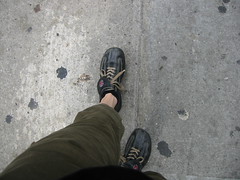
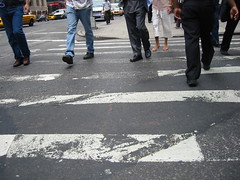
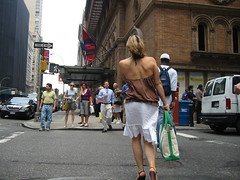
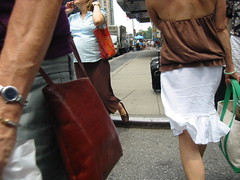
13 Responses to “walking”
Thanks so much for the rigorous documentation of your travels (in keeping with documentation you show/describe in your book!). Your description of walking makes me wistful – I love New York; I always feel like I could walk forever there. And your shoes make me jealous…
I _love_ that about intersections in NYC. I get bubbly with anticipation standing on a curb waiting for the light to change and the two walls to start flowing toward each other (esp. when it’s been a while since I’ve wandered the city). Thanks for writing of, and documenting, the feeling!
well, i find that the left-right dance only happens to me in places where people drive on the right (such as New York): in left-handed countries things are much smoother. your mileage (kilometerage) may vary.
love the blog though
How tall are you? People bump me all the time in Brooklyn…that is the Barnes and Noble where I met the Golden Girls…I can’t believe that you were there!!!
Great pix of New York. If I win the lottery, I will buy a flat in midtown Manhattan! I love the flavor and feelings of New York. New Yorkers are wonderfully gracious people as well.
I do the left right dance at least three to five times a day and that’s just walking down the corridors at work..I am English..and therefore follow through with a Sorry!!!
I too experience the dance in London. And, like Alison, never really had that in SF or New York. What I discovered about London walking is that if you just go, in a completely straight line, staring straight in front of you and not altering that, people will move around you. I’m in London for a performance degree, and in our movement/dance class we analyzed the phenomenon (yeah, I know, pathetic), and people all said that if you’re looking right at people, or are trying to predict where they’re going, you’ll definitely do the dance. If you walk like you own the road, you won’t…….yeah, its weird….and sad that we actually thougth this all out….
The cues for avoidance differ between New York and London, don’t they?
Consider the swords(wo)man defending the tower, inside the winding staircase, against invaders from below. Odds are that (s)he would be right-handed, and hug the left wall. Anything to do with choice of traffic lanes?
It’s all about eye contact: look the person coming towards you in the eye and there is no way you can avoid the dance. Break eye contact and immediately the two of you cruise past each other without effort.
I’m drawing interesting conclusions from this about people in London vs New York!
Ah, it seems to me the left-right dance is cultural – British people experience it in the US, US people in Britain. I’ve lived in both countries for several years and venture the hypothesis that British people usually pass on the left, Americans usually on the right, hence British people have to dance in NY and SF, since their culturally induced “instincts” don’t work there, and Americans have to dance in London, for the same reason. Well, just a thought.
I think the difference in behaviour between NYC and London may have to do with the layout of the streets. Manhattan, as a planned city, has mainly straight streets, while London, a much older city that grew up chaotically without any planning, consists–in its older parts anyway–of a tangle of streets that twist and turn and collide into one another within very short distances. In NY’s straight lines people may get used to staying on one side and just keep going, so it is easy for pedestrians to predict one another’s moves. In London, you need to cross from one side of the street to another constantly no matter where you want to go, so you never know where someone is going to go, and your movements are as unpredictable to them. I don’t think it is cultural; I think it is the environment enforcing behaviour.
Michael
Although I’m inclined to think that when a man comes up with a theory it’s more likely to be right than a woman’s (just kidding), I would like my theory falsified, before I believe Michael’s. I’ve lived many years in several European countries, including cities, and I hardly ever had to ‘dance’. When I moved to London age 27 and lived there for 15 years, I ‘danced’ for about the first 5-7 years, then no need anymore. When I moved to the US, I ‘danced’ again, only for a few months, though, then obviously readjusted to my European (non-British) experience, just as I quickly learned to drive on the right again.
So, is there anybody here who is British and has spent the first decades of his/her life in London, and then moved to New York, and who ‘danced’ while they lived in London, and stopped dancing when they lived in New York? Until such a person comes forward, I take my theory to stand (in the sense of not having been falsified or refuted). (Sorry for the jargon, but I teach philosophy of science, so it’s a habit.)
Having myself taken only a couple of undergrad courses in the history and philosophy of science I bow to Shereen’s considerably greater expertise in that area. And I confess to a serious error in scientific method: I can’t say that I have actually myself observed or experienced differences in the “dance”. I’ve been to both cities, but have not spent enough time in London to really be able to say what happens. My theory was proposed to explain what another person reported as having observed, and I may well have misunderstood that observation, and here is another observer who reports something different. A theory should be able to explain all accurate observations. Anyway, good fun to consider it.